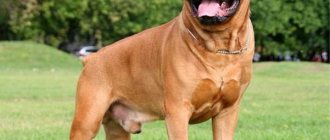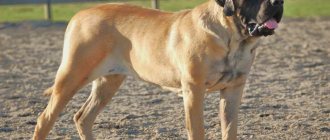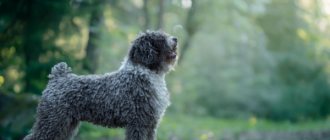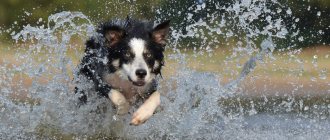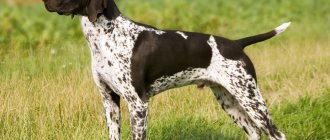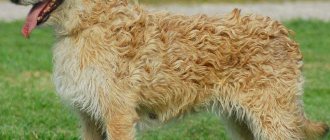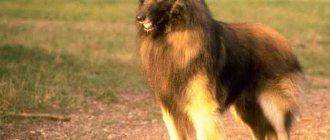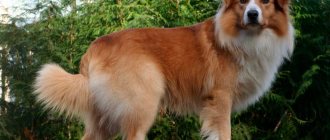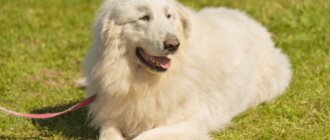Brief characteristics of the dog
- Other possible names: Boer Mastiff, Boer's Bulldog, Boer Bulldog, Boerboel, Boer Dog.
- Adult height: ideal height for males is 60-70 cm, for females 55-65 cm.
- Weight: the norm for a male is 60-75 kg, for a female 50-65 kg. It is not uncommon for dogs to reach 90 kg.
- Characteristic color: solid shades of brown with a black mask on the face.
- Coat length: short, smooth.
- Life expectancy: on average 12-14 years.
- Advantages of the breed: instant reaction, hardy, smart, loyal, excellent guards.
- Difficulties of the breed: wayward, dominant, there are outbreaks of aggression, they require constant physical activity.
- Average Price: A pedigree South African Boerboel ranges from $500 to $800 or more.
Appearance
The description of the African breed is not established in the world, but is accepted by the South African club; today, the Boerboel standard is quoted only from African sources.
One of the main indicators is the correct ratio of body weight and height. The gender indicator is bright, females are much smaller and lighter than males. All indicators of the standard can only be assessed in general terms; each of them is not considered separately.
- The weight of an adult Boerboel is from 55 to 85 kg;
- Height for a bitch at the withers – 50 – 60;
- Males: 57 – 70 cm.
Externally – large, heavy and powerful type of skeleton, developed muscles of the whole body, mainly of the dry type.
- Head: has a proportional size to the body of the animal, the shape is rectangular, and looks like a square from above. The forehead is visually wide, there is a well-defined furrow between the eyes. On the muzzle there is a fold of skin in the area of the bridge of the nose.
- Muzzle: visually wide, tapering, lips completely covering the teeth and mouth. There is slight sagging, the jowls are not large, they do not hang down very much.
- Jaws, teeth: strong with sufficient strength, large teeth in full set, correct bite, without distortion, scissor-shaped.
- Nose: large, with wide nostrils, dark in color.
- Eyes: round, widely set, brown in color, varying shades from light to black. The eyelids are painted over.
- Ears: triangles, medium size, high set, wide set, mobile, medium hard cartilage. Very mobile.
- Body: powerful back with pronounced muscle mass, not short, wide. The withers are visually highlighted, the transition to a wide, powerful neck is smooth. There are a small number of skin folds.
- Chest: wide type, voluminous, ribs well spread, pronounced, lean muscles.
- Limbs, paws: straight, widely set, powerful with well-defined muscles, hind legs and thigh – wider, stronger, muscles of special power. The paws themselves are gathered into a dense ball, and the toes are oval, the nails are black and hard.
- Tail: saber-shaped, much thicker at the base, hard. Highly placed.
- Coat: short-haired dogs, wool of a hard type, lying close to the body, elastic, thick skin. Pleasant to the touch, softer in some places. Mandatory black coloring - nose, eyelids, lips and palate. The presence of a mask on the face.
The color is varied according to the standard, the most common are brindle, red, bright red, fawn. The presence of white spots is acceptable in the chest and paws.
Individuals with obvious deviations from the established standard, as well as with a high percentage of white color, are not allowed for breeding and participation in exhibitions.
History of the origin of the breed
Boerboels appeared in South Africa in the 17th century during its mass colonization. By this time, the continent had already had its own large and strong Molossian-type dogs for several millennia. And some arriving colonialists, in addition to families and belongings, brought with them their faithful dogs.
This happened in 1652, when the future founder of the Dutch colony, Jan Van Riebeek, landed at the Cape of Good Hope. To protect his property, he took with him from Holland several loyal Bullenbeisers, who became the founders of the breed, eventually crossing with local dogs.
There is another, rather entertaining, but no less plausible version about the origin of Boerboels. About three thousand years ago, large dogs came to Africa along with travelers and traders.
The Ethiopians, without thinking twice, tamed these dogs and got used to milking them. Apparently this is where another name of the breed comes from, which sounds like “kinomolga”, which means “a dog that is milked”. Dutch emigrants who arrived on the continent in the 17th century examined and appreciated the guarding and hunting qualities of local dogs, calling them Boerboels.
From Dutch Boerboel is translated as Boer - peasant or farmer, and boel - bull. As a result, for a long time these dogs were called peasant bulls, and only after almost three centuries the name of the breed began to sound like “large farm dog.”
Later, the breed became interested in dog breeders in South Africa. They engaged in targeted breeding and made a unified description of these dogs, which is considered the breed standard. The South African Boerboel breed is not recognized by international canine organizations and is considered prohibited for keeping and breeding in a number of countries.
South African Boerboel
- home
- Articles
- Encyclopedia of Animal Species
- Dogs
- South African Boerboel
- Content
- About the breed
- Character
- Boerboel content
- Story
- Standard
The Boerboel is a massive, proportionally built dog, with large, dense bones and well-developed, prominent muscles. Boerboels are distinguished by their power and balanced psyche. Boerboels belong to the family of fighting dogs that lived in ancient centuries, and their closer ancestors are mastiff-like dogs, as evidenced by both the appearance and the characteristic features of the breed, characteristic of African giants. Boerboels are very agile and have good reactions. The plasticity and flexibility of the body allow them to move widely and elastically. The calculating accuracy and energy of this dog’s movements is amazing.
About the breed The South African Boerboel belongs to the Molossian group of dogs; large, but not huge. He is powerful, balanced, friendly. By temperament - a mixture of sanguine and choleric in reasonable proportions. He shows aggression only when there is a clear need, assessing the situation adequately, and is not malicious. Boerboels have excellent reactions, they are very dexterous and prudent in their movements. Boerboels are working dogs used to protect the territory, the owner and his family, both from animals and from strangers. The dog performs its task by moving freely around the protected area. There have been cases when Boerboels were used in round-up hunts as baiting dogs: they have an excellent sense of smell and the passion for hunting is not alien to them, but still this is not a hunting dog. Large size and weight do not affect activity and speed of movement. Proportional and harmoniously built animals move freely in any type of gait. The slightly elongated body allows them to move equally easily with a slightly lazy, slightly imposing step; a sweeping, free and therefore smooth trot, as well as a fast and powerful gallop. "Passage" - a type of trot with a high lift of the forelimbs at the elbows - is an exception, and "ambling" is considered a disqualifying fault. Until recently, the working qualities of dogs were valued in South Africa above the characteristics of the exterior, which is why Boerboels have good physical health and a calm, balanced temperament. They show neither unmotivated aggression nor excessive anger. The calm, friendly nature, excellent qualities of a working dog and a peaceful attitude towards others, especially children, allow these dogs to be used both for protection and as companion dogs. With proper upbringing and appropriate training, Boerboels get along peacefully with other pets, but you should keep in mind if you want to buy a Boerboel puppy that the first year will be very difficult, and in the future it is difficult to expect an easy life. Raising a Boerboel puppy should begin as early as possible, using the rule: “Soft heart and firm hand,” since dogs of this breed have pronounced personal and individual characteristics. They are characterized by stubbornness, independence, self-reliance. The breed is dominant, and in males the tendency to lead is more pronounced, and the strength and power of this dog will be a serious obstacle when adjusting the behavior of an adult dog. Show patience, consistency and firmness when raising a dog, and there will be much fewer problems in the future. Boerboels have undoubted intelligence and good memory, they are very smart, and therefore learn well and quite quickly. When following commands, they can be slow and "thoughtful", like most Molossians. Don't be fooled into thinking that the dog is limited or doesn't understand very well what is wanted of it. Slowness is a consequence of mental activity, natural cunning and ingenuity. The Boerboel, unlike many service dogs, does not act automatically, but after analyzing and assessing the situation in each case, so its reaction to a command may seem slow. He will always try to act with minimal costs, even unquestioningly obeying your commands. Over the years, becoming older and more experienced, the Boerboel turns into a fairly independent animal. A strong, mature, self-confident dog, who until recently was a funny little bumpkin, may decide that you are not so strong and are not always right, and will try to become a leader and dominate in communication with you. An obvious refusal to follow commands indicates that you do not enjoy the same authority. Perhaps serious mistakes were made in the process of upbringing and training. Urgent measures to restore authority in the eyes of the dog should be taken immediately, otherwise the habit of showing temper and insisting on your own will greatly complicate your relationship with your pet. The dog shows temper and tries to dominate already in adulthood, so it is necessary to seek advice and help from an experienced dog trainer, even if you have some training experience. An outside perspective from an experienced person can be not only useful, but also very valuable, and the cost of a mistake when correcting the behavior of an adult dog can be high. It will take a lot of effort, patience and desire, but all efforts will pay off handsomely if in a dog-human relationship, you are the main one. The character and personality traits of Boerboels are genetic, fixed over several centuries, as individuals with certain physical and mental abilities survived through the process of natural selection. Life is the strictest and most ruthless selector. Living and “working” conditions excluded stupid, overly self-confident or overly brave dogs from the breeding stock. All aboriginal breeds living in their natural habitat, close to nature, undergo such natural selection: sledding and hunting huskies, Central Asian and Caucasian shepherd dogs, Boerboels and ordinary mongrels, finally. With the purposeful breeding of most service breeds, the animals acquired the skill of unquestioning obedience to man, acting only on his command. Boerboels, due to the specifics of their duties, acted independently most of the time, determining the degree of danger of four-legged or two-legged opponents. Assessing the situation, they made decisions without waiting for a hint or command from the owner. An error in assessing the situation and incorrect actions led to the death of the one who made the mistake. The independence and confidence in their actions of Boerboels can also be explained by the fact that for many centuries no one limited their freedom of movement by putting them in an enclosure or on a chain. They ran freely across vast areas of Boer farms. The master's commands, when he appeared, were carried out unquestioningly; disobedience threatened death. The Boers had no time to think. When purchasing a Boerboel puppy, you should be well aware that this large and independent dog can be dangerous if not raised correctly. This opinion has serious justification: • A dog weighing 70 kg, in a jerk, can easily knock down a person weighing over a hundred kilograms. The data has been checked several times. There is no need to be surprised, since in weight-pulling competitions, a Boerboel that has not undergone special training can easily move a cart weighing 300–400 kg. • No dog can outrun a Boerboel in the open, let alone a human. If a person is at the same distance from both the Boerboel and the shelter, then he has no chance. In addition, the Boerboel is persistent in pursuit. • Heavy weight multiplied by speed turns the Boerboel into a battering ram that can be dodged but difficult to stop even for a well-prepared person. A blow to the back or legs of a fleeing person will most likely lead to fractures. • Boerboel's grip when attacking is dangerous for any “enemy”. The force of compression of the jaws of an adult Boerboel is such that the work of an instructor without additional hard shields, even in a suit of medium level of protection, is prohibited. Working in a suit with light protection is unacceptable, as it risks serious injuries. At best, the instructor will receive huge bruises and bruises, at worst - a crushed bone. Moreover, the Boerboel can grab any part of the body, so when working with the Boerboel, lower protection is also necessary. Considering the above, we can conclude that proper and complete dog training is a necessary and mandatory condition for the owner of a Boerboel. Only in this case will you be able to ensure your safety, the safety of your family and everyone around you, both people and animals who are not intruders. Working on the ZKS complex requires complete confidence in your dog’s controllability in any life situation. Boerboels, like most large dogs, do not fully mature until they are two years old. The dog must have a fully formed stable psyche before you try the “nipper”: any psychological breakdown can ruin a beautiful dog. You should not raise a dog by cultivating aggressiveness from an early age. Genie out of the bottle can be dangerous.
Character This breed was bred specifically for protection and protection. The dog should not be capricious or unbalanced. The correct reaction to punishment is admitting a mistake - the characteristic behavior of Boerboel. The character of the breed is its main advantage, attracting the hearts of lovers. A faithful and reliable friend, always knowing what you are thinking and sensing approaching danger - this is the true Boerboel. He subtly senses whether you like a person or not, and will share your feelings. He will know that you are afraid of something, Boerboel owners have confirmed this. All these qualities appear at an early age. He will warn you with his growl, as if saying: “I'm here. I will protect you even at the cost of my life." This is true, and if you allow him to attack, he will roar and fight like a lion, without thinking about himself. Aristotle called the ancestors of these dogs "Leontix" (sons of lions). The Romans also believed that Boerboels were the result of crossing a dog and a lion. The fight between the Boerboel and the leopard, from which the dog emerged victorious, was recorded on tape. The Boerboel gets along well with children and willingly takes part in children's games. He loves the whole family, is affectionate and gentle with everyone, without singling out one person as the object of special love. The dog believes that the whole family belongs to it, and will protect everyone, even at the cost of its own life. The requirements of the ancestors for Boerboel were simple: during the day they were sent with their children to the steppe to graze sheep and catch hares for children for lunch, and also to protect them from any danger. In the evening and at night, Boerboel lay near the fire, protecting the family from any evil that lurked in the darkness.
Keeping a Boerboel Breeding Boerboels in Russia has shown that these unique dogs from Africa easily adapt to different living conditions and adapt to almost any climatic conditions. Most of the livestock living in Russia are kept in ordinary city apartments. There are dogs that live in country houses, but they are kept at home, as a family member. There is experience in keeping and breeding dogs of this breed in suburban areas in separate, but specially equipped and insulated premises, with free walking. Some dogs live well outside all year round, and only in severe frosts do they sleep indoors in a heated room. The choice of keeping conditions is determined by the owner, but one should not forget that the climatic conditions of Africa and Russia are still different, and the dog should not be kept in too harsh conditions. In Russia, unlike South Africa, where sub-zero temperatures last for several days, the cold winter lasts 4-5 months; high humidity during the off-season, combined with large differences in average daily temperatures. Such tests are still too severe for a short-haired dog. The content should be such that there are no health problems. The owner also chooses the type of food himself. This can be either ready-made dry food or special canned food; a diet based on natural food is possible. The main thing is that it is well balanced and contains all the necessary mineral supplements.
History According to research, the Boerboel family tree begins in the time of Herodotus, in the vastness of Tibet, Assyria and Babylon. During the conquest of ancient Egypt, the Assyrians used dogs as soldiers, covering them with special protective armor. They were taken with them on long trips, and thus they gradually spread throughout the world. They appeared in Europe thanks to Alexander the Great. He received a gift of 156 dogs, specially trained to hunt lions and elephants, around 326 BC. Gradually, these dogs evolved into two different species: mastiffs, used as guards and soldiers, and hunters, used for food. Both species were large and powerful working dogs, with slight differences in appearance and structure. It is assumed that most breeds of the Western world originate from these two species. More than 600 years ago, Europeans began to develop new breeds from these basic species by crossing and selecting offspring with the most desirable qualities. Various breeds of hunting dogs were bred, there were shepherd dogs and guard dogs, but all new breeds were united by the strength of their ancestors. Jan Van Roebuck landed at the Cape of Good Hope in 1652 with his family and dogs, who were supposed to protect his family and home in this wild, unfamiliar country. The dog of the Bullenbitjer breed was large, massive, mastiff-like. By that time, the “original dog” had changed a lot, and in many European countries new types of mastiffs had formed, with distinctive features characteristic of a particular area. The settlers who came after Jan Van Roebuck also brought the best dogs to protect them from the dangers that could await them in an unfamiliar land. Thus, dogs from different countries appeared on the African continent. The settlers moved deeper into the continent, settling on isolated farms. Due to the isolation of farms and inbreeding, during the reproduction of offspring, the characteristic features of the Assyrian ancestor dogs (original dog) began to be restored. Difficult living conditions and difficult climatic conditions dictated their own rules, and only the strongest, physically healthy, hardy animals survived. Modern Boerboels have retained these qualities of their ancestors. At the time of the “Great Migration,” Boerboels already possessed many of the qualities that distinguish modern representatives of the breed. The Great Migration ended, and dogs living on remote farms interbred with each other, and only strong and strong dogs survived. The farmers who owned the first Boerboels wanted a family friend, a working dog and a guard dog. They didn't want sickly, unruly, aggressive or stubborn dogs. At the beginning of the century, the features characteristic of the original dog were clearly visible, and the dog became widely known as "Boel" (translated from Old Dutch - dog). Urbanization that came to the continent almost became tragic for this breed: the typical “Bull” began to gradually disappear. However, in the early 80s of the last century, several brave breed lovers decided to revive the “Buley”. Having joined forces, they visited various parts of South Africa, covering a distance of 5500 km. They examined 250 animals, and selected 72 dogs that belonged to different bloodlines. They served as the basis for the original breed register. This is the history of the breed, which today rightfully wins the hearts of people all over the world. The big dream turned into reality, it took years of hard work and the inexhaustible enthusiasm of those who were at the origins of the Boerboel revival. Since then, every year in early November, breed lovers gather for their rally. In 1983 The Boerboel breed received official recognition in South Africa, and the South African Boerboel Breeders and Fanciers Association (SABT) was founded. In 1991 The Historical Boerboel Breeders' Association of South Africa (HBSA) was registered, the main purpose of which is to protect the historical appearance of the Boerboel from enterprising “merchants” who care little about the purity of the lines and compliance with the characteristic breed characteristics of the Boerboel. At the beginning of 1980, five Boerboel enthusiasts and lovers held a meeting in Senekal, in the building of the Higher School. They were united by a common dream and a common love for a dog - the inseparable companion of their ancestors. Early in the morning, one after another, the meeting participants began to arrive: 1. Johan de Jager - a farmer from Natal, specializing in sheep breeding, and having a Boerboel breeding nursery. 2. Lucas van der Merwe, his ranch was located in Kroonstad. He arrived with his giant dogs, Boerboels Piestiek and Flenters. 3. Johan du Preez of Senekal built bridges. He arrived with his dogs Leeuw, Duiwel and Mosadi. 4. Mrs Owen Read of Warden. 5. The Nel family, who lived in eastern Freestate, also brought their dogs. Only a few students came to the meeting, interested only in the free tea and cakes. And yet, the Society of Breed Lovers was born, after which work began to revive the breed. Following the advert for Boerboels, people became interested in this breed. They were potential members of the Boerboel Society. At least some of those who have had a significant influence on the revival and development of the breed should be mentioned: Leon Riekert from Pretoria; Babs Bosman of Douglas; Ella Louw from Volksrust; Steyn Opperman of Ficksburg; Nic Van der Linde from Standerton... and many others. The number of members of the organization was constantly growing. In 1990, a short documentary about the Boerboel was released by the South African Boerboel Society (SABT). The film, which raised questions about where and when this breed appeared, marked the beginning of a lot of research work. Active participants in this work were Lucas van der Merwe and his wife Anneke. They traveled to Cape Town and the Northern Territories and met with the famous dog history expert, Dr. Daan Marais, who lived in a real castle with a baobab tree in the center of the living room. The conversations lasted four days among old books, paintings and drawings. Gradually, more and more information about Burbula became available. The British Natural History Museum turned out to be a valuable source of information. It contained a copy of a painting from 1400 depicting King Charles surrounded by his courtiers. In the center of the environment was a dog, similar in appearance to a Boerboel. Information from old books and images in engravings provided information to answer questions about the origins of the Boerboel.
Standard Official breed standard KUSA Author: Date of publication: 2003-06-26 Boerboel. Historically, the Boerboel began to develop as a farm dog in the 17th century, arriving in South Africa with the first settlers. These dogs were excellent watchdogs, being the first to greet uninvited guests; could track and catch a wounded animal. Old farmers knew many legends about their strength, courage and dexterity. In the difficult and harsh conditions of South Africa, only the most resilient and strong dogs could survive. The Boerboel is a large, strong, intelligent, confident working dog.
It has excellent guard qualities, obvious and beyond doubt.
For this reason, today both South African farmers and city dwellers choose the Boerboel as a guard dog. The origin and purpose of the breed must be taken into account in order to preserve the unique qualities of this South African Mastiff. The type, constitution, functional efficiency of the breed, its psyche are equal components of the breed and must be taken into account in its development. The purpose of this Standard is to provide a clear and uniform idea to judges and breeders of what constitutes an ideal Boerboel. BREED STANDARD. 1. General view.
The Boerboel is strong, powerful, balanced, muscular, looks impressive and imposing.
The bones are strong. The coat is smooth. Correctly built, without obvious defects due to inbreeding. Males should look more masculine than females. The movements are smooth, light, powerful, not expected from such large dogs. The build is symmetrical, balanced, proportional. The sexual type is clearly expressed. Females are feminine, smaller and lighter than males. 2. Behavior and character.
An obedient, reliable, well-managed and trainable dog.
The guard instinct is clearly expressed. Loyal to all family members. Thanks to its self-confidence and courage, it is a reliable, calm and balanced dog. Faces any danger fearlessly and courageously. Education, training and socialization must begin at an early age. 3. Head.
The appearance of a Boerboel is of exceptional importance in evaluation, since it characterizes the distinctive feature of the breed.
It should be proportional to the body, wide, deep, square. The muscles are well developed. Cheekbones are well filled. The top line of the head is wide and flat, with prominent muscles. The chewing muscles are well developed. The transition from the forehead to the muzzle should be visible, but not pronounced. The furrow between the eyes is shallow. The muzzle is deep and wide, well connected to the skull, the space between the eyes should be well filled, slightly tapering towards the nose. The top line of the muzzle is straight, parallel to the top of the skull. The length of the muzzle is slightly more than a third of the total length of the head (for females with the desired height this is approximately 8cm, and for males - 10cm). The nostrils are wide and well open. The nose is large, located on a straight line, forming an angle of 90 degrees with the lower jaw. The jaws are strong, deep and wide; slightly tapering forward. The teeth are white, well developed, correctly spaced, a complete set (42 teeth), a scissor bite is most desirable. The upper lip is loose and fleshy and should not fall below the lower jaw. The lower lip is close-fitting without excessive jowls. The eyes are set straight, round in shape, medium in size, and widely spaced. They are not set very deeply, should not be convex, the eyelids are strong and well pigmented. The color is light brown, yellow-brown or dark brown according to the coat color. The darker the better. The ears are medium-sized, V-shaped, proportional to the size of the head. Quite high and wide set. The base is wide, the edges are rounded. When the dog is interested, the ears form a straight line with the top of the head. The expression of the muzzle is attentive, inquisitive and self-confident (an angry, cowardly, nervous - wary expression is unacceptable). 4. The neck is
of medium length, powerful, firmly and high set.
Gradually expanding, it passes into the withers, the skin of the neck is free, forming a dewlap. (The neck muscles of females are less pronounced than those of males, but are balanced with the head and body). 5. Body.
The length of the body from the shoulder horizontally to the vertical through the end of the croup is approximately 85% of the height of the dog at the withers.
(The lengths of the chest, loin and croup are approximately 2:1:1). The body is rectangular, with well-developed muscles, strong, wide and deep. The back is straight and wide, the muscles are pronounced. The lumbar region is slightly convex and muscular. The sternum is lowered to the level of the elbow. The depth of the body is approximately half the height of the dog at the withers. The transition from the chest to the lumbar region and from the lumbar region to the croup is full and not sharply expressed. 6. Chest.
Muscular, wide, powerful.
The ribs are well sprung. forelimbs .
Well filled behind the shoulder blades.
The manubrium of the sternum (forebreast) is at the same level as the angle of the glenohumeral joint. Shoulders fit well. (Not free). 7. Lumbar region. The loin is short and straight,
slightly narrower than the chest and croup.
A slight bend in the lower back is allowed (especially in young dogs);
the lower back muscles are well developed. The groin is moderately selected.
The depth of the groin is slightly less than the length of the lower back. 8. Sacrum, croup.
The sacrum is wide, strong, muscular, proportional to the rest of the dog’s body.
The topline slopes smoothly to the tail. The croup is wide, powerful with well-developed muscles.
The tail is thick,
set high, straight, and docked short, although long tails are allowed.
The tail is docked at the level of 3-4 vertebrae.
X
is well covered with hair.
A looped tail is not acceptable. The undocked tail should extend almost to the hock joint. 9. Limbs.
Weak or malformed limbs are not acceptable as they compromise the physical functionality of the Boerboel.
10. Forelegs. Strong and muscular, standing strictly vertical.
The elbows are pressed tightly to the chest and parallel to it.
When viewed from the side, the forearm is positioned vertically. The pasterns are short, strong, and set vertically. The shoulder blades are oblique, the angles are pronounced. The paws are compact, rounded with well-developed pads.
The toes are well curved, there is fur between the toes, and
black nails are desirable. The paws should not look flat, they should be directed straight forward, and the kozinets should not be placed too high. 11. Hind limbs. Strong, robust, in proportion to the rest of the body.
Must allow for quick movements. The hips are wide, deep, well developed, with prominent muscles. When viewed from behind, the outline of the hind legs resembles an inverted U, with the knees pointing straight forward and the hocks pointing back.
The lower leg is muscular and well developed. The knees are strong, strong, well defined. The hock joints are strong and smoothly arched. The hocks are relatively short, strong, parallel to each other (there should be no dewclaws). The hind legs are slightly smaller than the front ones, with well-developed pads, rounded, directed straight forward. The claws are dark and rounded. Movements are light, smooth, powerful, due to good movement of the front paws and parallel movement of the legs. When moving, the topline remains straight. Unbalanced, uncertain, weak movements or heavy gait are unacceptable 12. Skin.
The skin is thick, does not fit tightly, and is mobile.
A slight dewlap on the neck and wrinkles on the forehead are possible. 13. Pigmentation. The Boerboel is well pigmented.
The lips, palate, eye rim, nose, paw pads, nails and genital area should be pigmented black.
14. Wool and color.
The coat is short, thick, smooth, close to the body, and shiny.
Acceptable colors: - plain fawn, red, with or without a mask; - brindle, representing asymmetrical black lines on a fawn or red background; - small white spots on the chest and limbs, located no higher than the wrist and hock joint, are allowed. Markings of other colors are not acceptable. Dogs with white spots are not desirable for breeding or for participation in exhibitions. 15. Size.
What is important is not so much height as proportionality and balance of all aspects of the dog.
The ideal height for males is 66cm, but not lower than 60cm. The ideal height for females is 61cm, but not lower than 55cm. 16. Genitals.
Both testes in male dogs should be well developed and completely descended into the scrotum.
Flaws.
Any deviation from the above standard is considered a deficiency, the severity of which is determined by the degree of its severity.
Disqualifying faults.
1. The dog is too small (less than the minimum allowed according to the standard). 2. The dog is too big and unbalanced. 3. Obvious aggressiveness. 4. The head is too small and not typical for the breed. 5. Lack of pigmentation. 6. Pronounced undershot or undershot bite. 7. Blue eyes. 8. Prick ears. 9.Black or piebald color. 10. Pronounced deviations from the norm in physical development and behavior.
Health to you and your pets!
© 2021 Team “ZOOVET” We are always happy to help you! 24-hour consultation: +7 Make an appointment [email protected]
Return to list
Purpose of the breed
Before the arrival of Europeans on the African continent, local tribes primarily used Boerboels as milking dogs. After the dogs were milked, they began to perform their guard and hunting duties.
Thanks to their endurance, strength and fearlessness, Boerboels, both before and now, take part in pack hunting for large animals. They can fight both an antelope and a powerful lion. And a pronounced sense of ownership makes this breed ideal guards who instantly react to danger, clearly distinguishing between an imaginary threat and a real one. In addition, Boerboels are excellent bodyguards.
Description of the nature of the breed
The African Boerboel is a serious, dominant breed of working dog. They will faithfully serve only one master, but only if they see him as a strong leader. These dogs are not at all suitable for people who do not have much experience in raising and maintaining such breeds.
The Boerboel needs to be socialized and trained as early as possible. Although they are considered dogs with a stable psyche, there are frequent cases of unjustified attacks of aggression and attacks on people, including children and their own owners. As a rule, this occurs due to improper upbringing and lack of physical activity.
The vicious nature of the Boerboel usually completely excludes aggression towards humans. During the formation of the breed, individuals that showed such qualities were not allowed for further breeding and were immediately shot. There are different reviews from owners about the Boerboel breed. Some people like her and really like her, but others consider her cruel and unbalanced.
Boerboels are intelligent and have a good memory, but they are also very stubborn and willful. Even if they perceive the owner as a leader, they still try to show their dominance and independence. From an early age, they are fiercely ready to defend everything that belongs to them, perceiving the master's family as their property, which they are obliged to protect.
To some extent, Boerboels can be called trusting and calm. And they also don’t have mood swings. Despite their strength and power, they are quite sensitive to children and can be very good and gentle nannies.
They perceive other animals as competitors or objects of hunting, although sometimes they manage to get along well even with cats. You should not walk your Boerboel where other dogs are running.
How to choose a puppy
Any admixture with dogs of such serious breeds as the Boerboel is very undesirable. This may not always have a positive effect on the dog's character. It is better to buy puppies in nurseries , where they monitor the purity of the breed and the compliance of the pets not only with external standards, but also with the character and temperament of the dogs.
Go for a puppy only if you are completely confident that you will be able to raise a Boerboel, and not turn it into an unbalanced monster. And it’s better to do this when the puppies are 1.5-2 months old.
The sooner you bring your dog into your home and start training it, the higher the confidence that the puppy will grow into an obedient and well-mannered companion. You also need to take into account that males are less flexible and more often show their restive disposition than females.
Healthy Boerboel puppies are plump, strong, covered with smooth and shiny hair. The paws should be strong and parallel, and the gait should not wobble excessively. A well-groomed puppy will have clean ears and eyes and no bad breath.
Since Boerboels are distinguished by their fearlessness, their puppies will also be curious and courageous, and not timidly hide in a corner from a sharp sound. Take the kid who will curiously run up to sniff the outstretched hand and will not hesitantly and cowardly back away.
How much do South African Boerboel puppies cost?
The South African Boerboel dog breed came to Russia in the 90s of the 20th century. Since then, the animals have gradually won the love of local dog breeders. However, there are not many nurseries specializing in breeding these particular pets. Therefore, purebred puppies are quite expensive.
Average prices in Russia range from 30-50 thousand rubles. – it all depends on the class of the animal, its compliance with the breed standard and the reputation of the nursery. Pet class is cheaper, show class is more expensive. The choice depends on the purpose for which a person gets a pet.
On the Internet you can find private advertisements for the sale of Boerboel dogs - the price of such animals will be significantly lower. However, purchasing these puppies is risky - without the appropriate documents, the seller will not be able to guarantee their health and belonging to the breed.
Dog nicknames
A dog of such a bold, courageous and proud breed should have an appropriate nickname. It will emphasize his power and endurance. It is desirable that the pet's name be monosyllabic, quickly remembered and not confused with commands.
For example, for a male Boerboel, nicknames such as Adar, Bert, Weiss, Dokoit, Zhigan, Croyd, Madge, Norvis, Ralph and so on may be suitable. The bitch can be called Alko, Atika, Berna, Veysi, Hera, Cora, Neji, Ronda, Tinga and similar names.
Care and maintenance
All Boerboel care involves keeping the dog clean. First of all, this should be periodic cleansing of the eyes and ears. Do not ignore treatment for ticks, fleas and worms. You should only bathe your Boerboel when absolutely necessary.
It is recommended all dogs of these breeds in a private house with a fenced area. They need a spacious enclosure with a booth in which the dog will feel comfortable both in summer and winter.
The size of the booth must match the size of the pet. But Boerboels cannot be kept closed all the time. From constant loneliness and without the opportunity to communicate with people, dogs become aggressive and cruel.
Such dogs require extensive and exhausting physical activity, preferably twice a day. It is best to walk Boerboels in closed dog areas with an obstacle course, taking a stick or ball with you. You cannot walk dogs of these breeds near playgrounds and without a muzzle.
Boerboel care
The Boerboel's weak point is its ears - you need to take special care of them. The dog loves not only to run, but also to do other physical exercises. The dimensions of the cables are approximately ten centimeters larger than the branches.
The South African Boerboel's short, dense, thick coat is quite easy to care for. The dog needs to be brushed once or twice a week. Regular grooming removes dead hair and also massages the skin, improving blood circulation. During grooming, check your dog for signs of fleas or ticks.
It is highly advisable to brush your dog's teeth regularly.
Bathe your South African Boerboel only when necessary, using a special dog shampoo and conditioner. Bathing too frequently can cause excessive dryness of the skin and coat.
The South African Boerboel's nails should be trimmed periodically to prevent them from becoming too long. Use a dog nail trimmer to do this; avoid using nail scissors as this can cause your dog's nails to split and chip.
Despite its large size, the South African Boerboel does not require special exercise to exercise. They are able to exercise independently if they have a large fenced area, periodically patrolling it for safety. They will also be happy to play with other familiar dogs, thus receiving additional physical activity, without any effort on the part of the owner.
South African Boerboels make excellent walking and jogging companions. They love to go on family outings and are usually well-behaved if trained and socialized properly.
South African Boerboels' favorite pastime is playing with children in the yard. They love to have things thrown at them and can spend a lot of time chasing a ball or stick.
As South African Boerboels age, they become less active. If your Boerboel begins to move very little and gain weight, the owner needs to provide him with regular exercise that will help him live a healthy and happy life.
Possible health problems
Problem areas for the Boerboel, like other large dogs, are the joints. Quite often they have dysplasia of the hind or forelimbs. This is a hereditary and incurable disease that sometimes causes unbearable pain to the dog.
To prevent it, it is not recommended to give the dog various stimulants during the period of active growth, and you should not get too involved in physical activity for up to six months. You should also not overfeed your dog, causing it to become obese. This, in addition to stress on the joints, can cause heart problems.
Periodic visits to the veterinarian will help identify the disease at an early stage. He will also tell you about the necessary vaccinations against severe infectious diseases.
Health and illness
Boerboels are dogs with good health, so genetic problems rarely plague them. They are quite active until old age, and their life expectancy is from 10 to 15 years. Among the ailments of Boerboels, the most common diseases that can affect the dog’s quality of life are: diseases of the musculoskeletal system (hip and elbow dysplasia, arthritis, bursitis, ligament rupture); allergies (most often to food); dysbacteriosis (often a consequence of the presence of helminths, eating low-quality or unsuitable food); otitis (occurs in Boerboels due to the presence of ear mites, bacterial infection, etc.); hyperplasia and prolapse of the vagina in bitches.
Nutrition for puppy and adult dog
Most of the Boerboel's diet should consist of lean meat, which is best boiled when feeding a small puppy. Meat can be replaced with offal, including cartilage, which is good for your dog's joints. Sometimes you can give boiled sea fish, as well as fermented milk products. As for cereals, it is better to give preference to rice, oatmeal or buckwheat.
You can feed your Boerboel with ready-made food, as well as alternate it with natural food. Such feed must fully satisfy the animal's needs.
The bowl should be removed after each feeding. Overfeeding is not very good for your dog's health. Therefore, you need to monitor the amount of food and feed your dog at the same time. Puppies are initially fed four to five times a day, and then gradually transferred to the adult diet and fed in the morning and evening.
Large dogs should not be fed from the floor. The bowl should be at chest level. To do this, you can purchase a special adjustable stand. And you definitely need to make sure that your dog always has a bowl of water.
Nutrition
Proper natural food for a dog is mostly a monotonous, species-specific diet that does not require heat treatment, mainly consisting of fermented milk products of medium fat content, raw meat or raw offal (heart, tripe, kidneys, etc.) and plant foods (vegetables and some unsweetened fruits) in raw form, as well as in the form of bran from cereals as an additive to the main diet.
Actually, cereals (porridge and other flour products) should not be present in the dog’s diet. Porridges and products made from or with the addition of flour contain easily digestible carbohydrates, which can cause disruption of the intestinal microflora, as well as a decrease in resistance, in all dogs and cats, which are known to be carnivores. The state of the animal’s health directly depends on the state of the intestine, which is a key organ not only in digestion, but also in providing the defense system (resistance and immunity of the body). Thus, the presence of dysbiosis in the intestines, which is facilitated by disturbances in the diet, can lead to the development of a host of pathological processes, including an increased tendency to allergies, disruption of the functioning of internal organs, the occurrence of a number of chronic inflammatory diseases and obesity, often associated with each other.
We advise you to read: Dog breed Kurzhaar (German shorthaired pointer)
The health and resistance of animals depends very much on nutrition; the state of the gastrointestinal tract and healthy intestinal microflora play a very important role in this. If your dog's diet includes cereal or commercial dry food that contains from 40 to 55% grains, corn or sweet potatoes, then you cannot expect normal, healthy intestinal microflora. However, even with a natural diet, digestive disorders are possible, indicating a painful condition of the dog.
Briefly about training
Raising a Boerboel must be done from a very early age. Such a dog should be trained by a self-confident person with a strong-willed character, who will become a leader for the dog. But even in this case, from time to time the Boerboel will show its independence.
This can usually be corrected by persistent daily training. But if the dog stops obeying, it means he felt insecure from you. Such a dog may become uncontrollable in the future, so you should definitely seek help from a dog handler and, under his guidance, continue training and guide the pet in the right direction.
Advantages and disadvantages
South African Boerboels are formidable and powerful , but at the same time affectionate and loyal dogs. They love to play with children, especially if they play with a ball or a stick. For the most part, they are balanced and non-aggressive towards their family. And these dogs treat strangers with great distrust, and in some cases even with anger.
When getting a Boerboel, first of all you need to take into account the fact that this is a dominant dog that will always try to show dominance and independence in everything. Secondly, the owner of the dog must be a strong and adequate person. Thirdly, this dog needs serious training.
It is advisable to take special training courses with her. And fourthly, the Boerboel needs daily exhausting walks with physical activity. From lack of exercise and improper training, Boerboels can become prone to spontaneous attacks of aggression.
If you follow the rules for keeping such dogs, you will be surprised by their intelligence, devotion and affection. For you and your family, the Boerboel can be an ideal bodyguard companion who will also become a patient nanny for your child.
Owner reviews
Novel:
At first glance, the Boerboel creates the impression of a formidable and powerful animal, upon seeing which it is unlikely that anyone will dare to break into your house or try to attack you. But having gotten to know this breed better, I was very surprised at how sweet and affectionate these creatures are.
Michael:
A very loyal and intelligent breed. For six years now I have been amazed how this pile of muscles can be so agile and agile. It’s also touching to watch them sleep with a cat in their arms.
Regarding aggression, I want to say that any dog needs to be dealt with. Otherwise they often start it up for the sake of pathos, and then they take their head off.
I would like to know your opinion about the South African Boerboel breed. Tell us how difficult it is to keep such a dog, and we also look forward to your advice regarding their training and education.
Share
Leave a review
Description
The appearance of the South African Boerboel confirms that the dogs belong to one of the most ancient species - mastiffs. These are strong, powerful, dexterous and flexible animals. They are able to cover long distances in a matter of seconds. The dog's appearance looks like this:
| Appearance | Characteristics |
| Dimensions | The height of the South African Mastiff at the withers ranges from 59 to 71 centimeters, weight is in the range of 69-91 kilograms. Despite these parameters, the animal is maneuverable and fast. |
| Head | The shape resembles a rectangle, wide. The chewing muscles are well developed. Proportional to body type. |
| Muzzle | Deep, wide. Folds appear when a four-legged pet is captivated or wary of something. |
| Jaw | Wide, powerful, with a scissor bite. |
| Ears | The head position is high. With a wide base they taper towards the top. The tips are slightly rounded. |
| Eyes | Oval in shape, widely spaced from each other. |
| Body | Elongated body, rectangular in shape. The muscles are well developed. The back and croup are slightly convex. |
| Paws | The limbs have well-developed muscles. The shoulder blades, thighs and lower legs are strong and strong. The paws are wide and rounded. |
| Tail | The landing is high. Wide. It can be stopped at the owner's request. |
| Wool | The cover is smooth, thick, short. The following shades are acceptable: fawn, brown, cream, brindle, piebald, red. Most representatives of the breed have a black mask on their muzzle. |
Such exterior features make the dog hardy, strong and fast. These qualities emphasize the virtues of a guard dog and protector.
